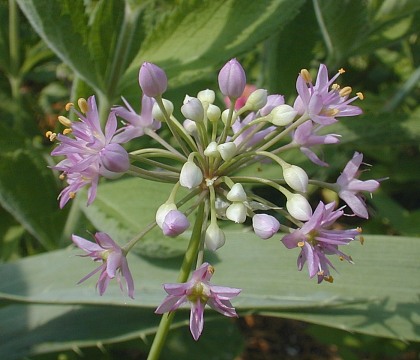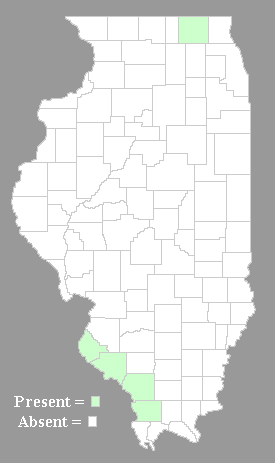Description: This is a herbaceous perennial plant. It has relatively few basal leaves that are linear, flat, solid rather than hollow, and about ½-1' in length. They tend to recurve outward from the base of the plant.

The flowering
stalk emerges among the leaves and is about 1-1½' tall. It is more
stiff than the leaves and remains erect. The attractive flowers are
arranged in an umbel at the top of this stem – this umbel is about 2-3"
across. Each flower is white, light lavender, or pink, depending on the
local genotype, and is shaped like a small star with 3 petals and 3
sepals that flare outward. Each flower is slightly more than ¼" long.
The blooming period occurs during late summer for about 3 weeks, by
which time the basal leaves will have died down if the weather has been
dry. The entire plant has a typical onion-like smell. The root system
consists of a bulb with unusually deep secondary roots for such a small
plant. This, no doubt, promotes survival during dry weather. If
conditions are favorable, the Cliff Onion will slowly cluster at the
base, or reseed itself.

Cultivation:
The preference is full sun and dry conditions. The soil should be
rocky, rather limey, and well-drained. However, this plant will grow in
ordinary garden soil and average moisture conditions if competition
from taller,
more aggressive plants, is eliminated. The Cliff Onion is slow growing,
but easy to establish, if the preceding conditions are satisfied,
otherwise it is likely to become lost in the surrounding vegetation.
Range & Habitat:
The native Cliff Onion is a rare plant in Illinois, occurring
in only a few
counties, primarily along the Mississippi River in the SW region of the
state. Natural habitats include rocky limestone bluffs and cliffs along
rivers, limestone glades, and hill prairies. This plant occurs in more
ordinary prairies in areas to the west of Illinois because of the drier
conditions.
Faunal Associations:
The flowers attract small flying insects, primarily flower flies and
small bees. Most native herbivores probably do not feed on this plant
because of the onion scent and spiciness of the leaves. However,
livestock are known to eat the foliage of native onions along with the
grass in pastures.
Photographic Location:
The above photograph was taken at the webmaster's wildflower garden in
Urbana, Illinois.
Comments:
The Cliff Onion has a delicate beauty when in bloom, resembling a
starburst effect. Sometimes this plant is called the 'Prairie Onion,'
however it is more typically found along rocky cliffs and limestone
bluffs near rivers in Illinois. The foliage and bulb of this onion are
edible, if somewhat strongly flavored. The Cliff Onion differs from Allium
cernuum (Nodding Onion) by its more erect inflorescence and
slender leaves. It resembles Allium canadense (Wild
Garlic), but doesn't produce any bulbets in the infloresence. The Allium
spp. from the Old World, such as Allium vineale
(Field Garlic), have round hollow leaves, while those of the New World
have flat solid leaves.